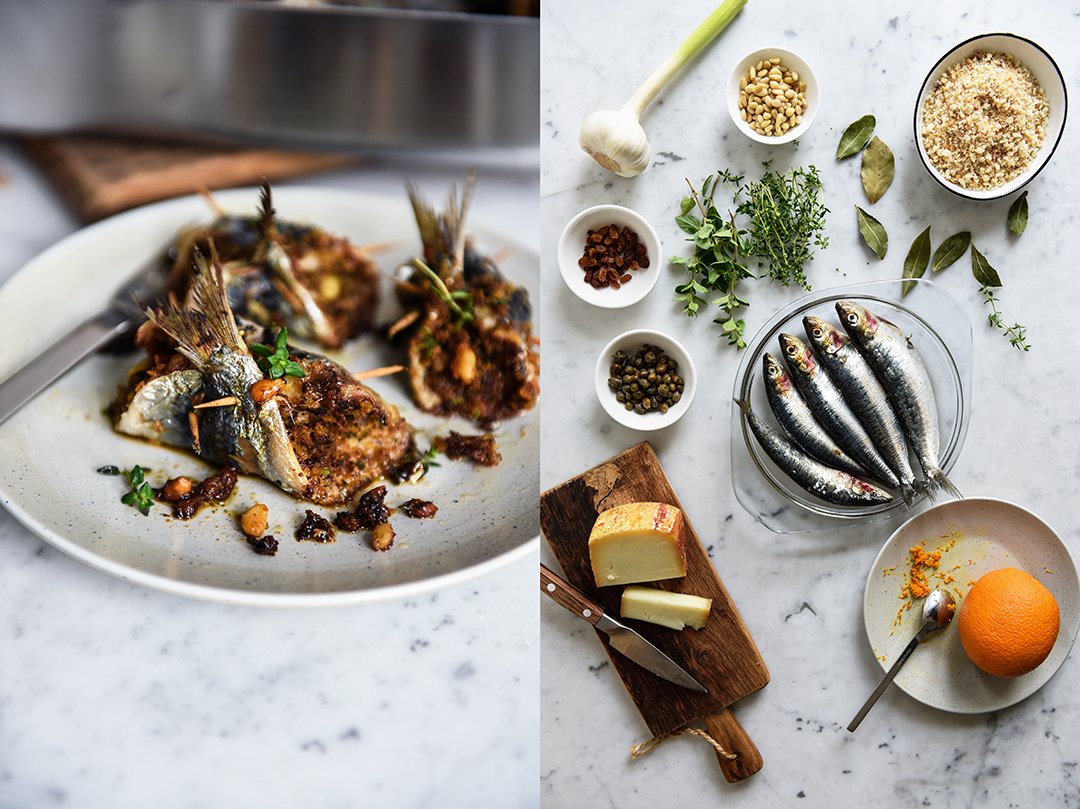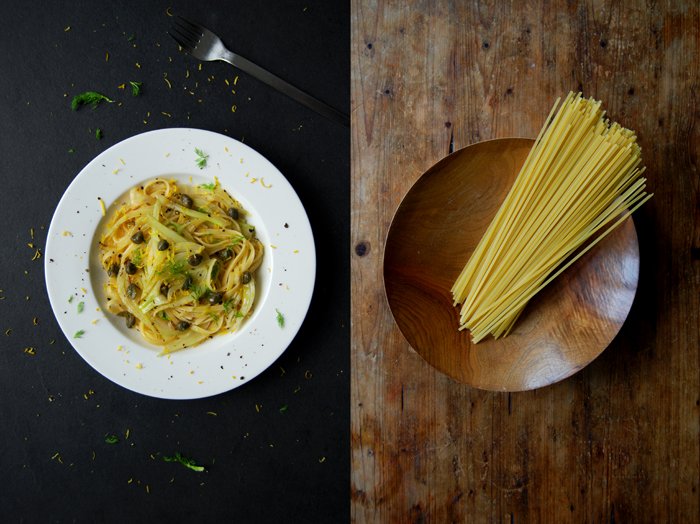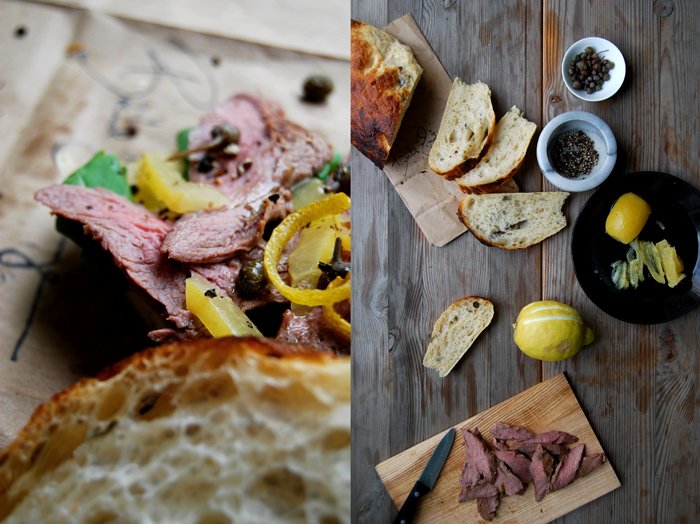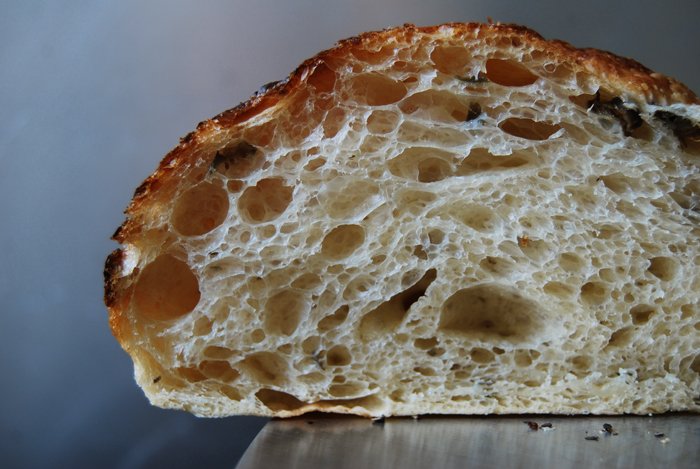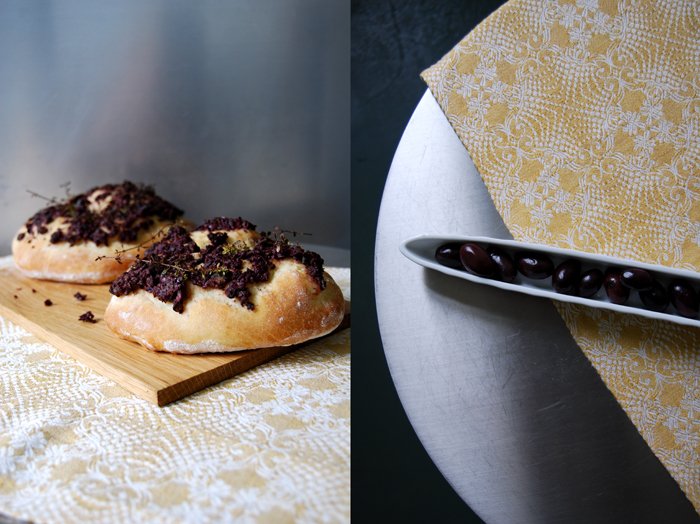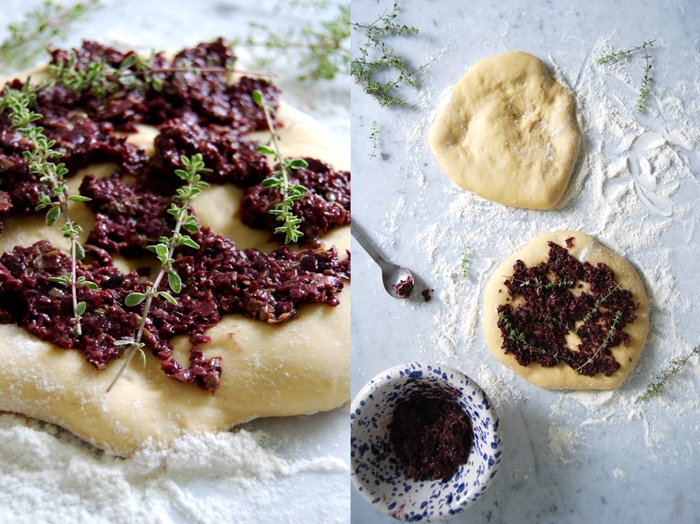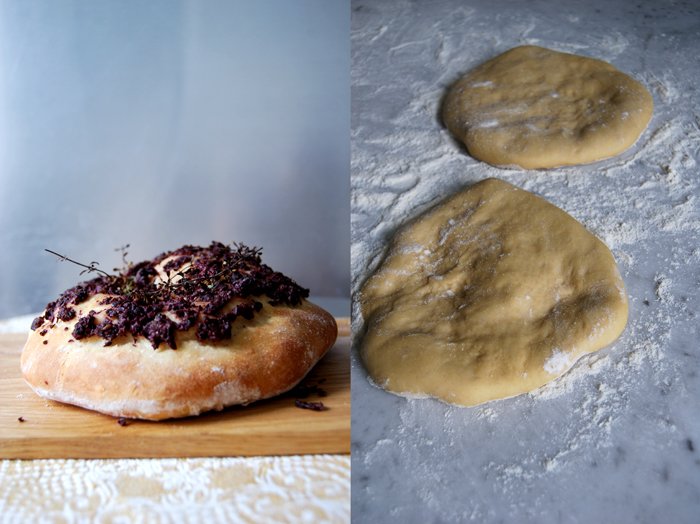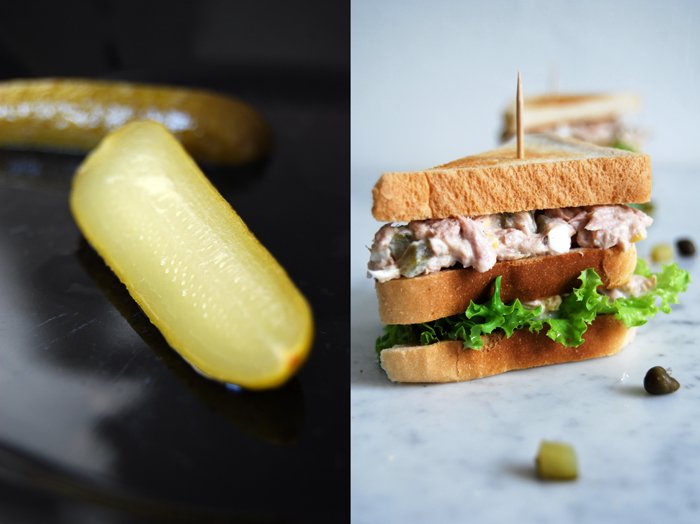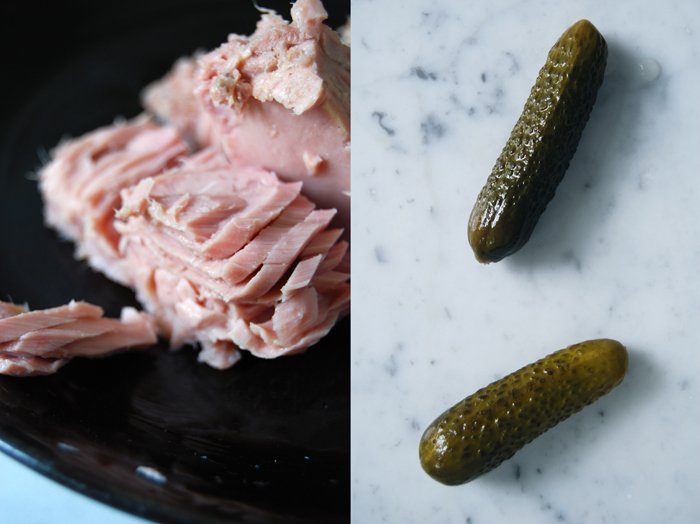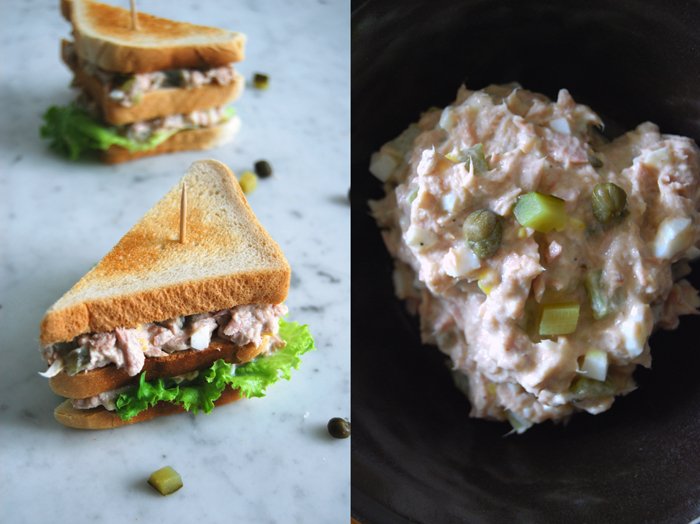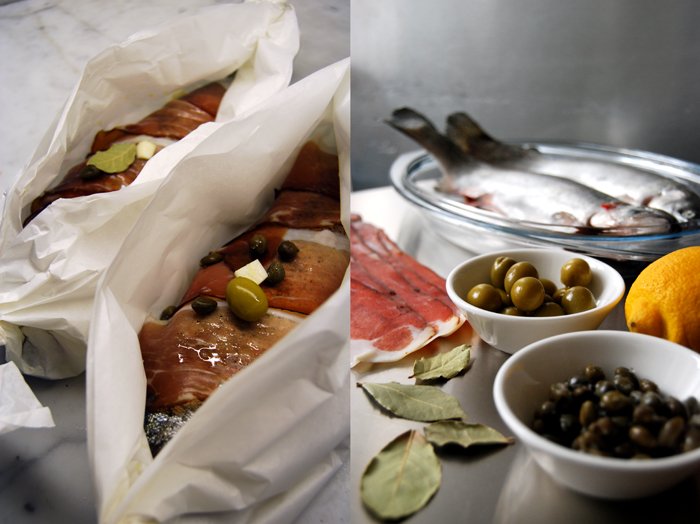Sicily and Stuffed Sardines
A few years ago I visited a tiny Sicilian island. It was so small that I either walked, rode my bike or swam to get around. But most of the time I did nothing, just laid on the rocks at the beach or in the garden, staring into the sky, amazed by how beautiful the world is. I only used a car when I arrived to get to the little farm where I stayed, a sturdy stone building tucked in between fig trees, hibiscus and oleander; and to go back to the harbor at the end of the trip, speechless and sad to leave this little piece of heaven.
In the past couple months I've been thinking a lot about this tiny island in the Mediterranean, dreaming of a place that feels safe and makes me happy. The house was part of an organic farm and I could pick all the fruit and veg right from the fields. The juiciest tomatoes, sweet bell peppers, soft figs, zucchini, eggplant ... As soon as I fell out of bed I'd walk - still in my pyjamas - through the field to pick zucchini flowers and fry them for breakfast. The farm's olive oil and wine I basically enjoyed from tap and although there wasn't really the need to, I also visited the island's fantastic restaurants and bars almost daily. If I had to eat Sicilian food for the rest of my life I'd live a happy life.
Dinners were spectacular: the freshest grilled fish and sun showered vegetables, raw prawn carpaccio, lobster, pasta, risotto and nana's almond cake - and bay leaf schnaps for dessert. Unforgettable, there's no doubt. The little luncheons at the piazza, at a rustic bar where mamma herself cooked all morning and laid out her delicious work on the counter by noon, was the food that melted my heart. Casseroles, lasagna, tarts, focaccia and stuffed vegetables, fish and saltimbocca, framed by hearty salads made with legumes. I went there almost every day, pretending to go just for an espresso before snorkeling but always ordered more plates than could fit on the round bistro table. The table was strategically placed in the shade of a large tree, close enough to mamma's kitchen to order more food but still in the middle of the airy piazza to follow the village's late morning life. This is the Mediterranean (to me).
So at this unimposing cozy bar, I enjoyed my first Sicilian stuffed sardines. The fish filets were wrapped around a filling made of breadcrumbs, orange zest, crumbled bay leaves, pine nuts, raisins, capers, fresh oregano and thyme. The whole bold and colorful culinary orchestra that Sicily's cuisine is famous for in one single bite. Don't ask why but it took me two years to recreate this recipe in my own kitchen. Last Saturday I was in the mood for a Sicilian lunch, so I drove to the fishmonger. The recipe worked out perfectly - I only should have bought more fish. It was a little feast for two. Five stuffed sardines were just enough for a lunch nibble, for a main I'd go for ten sardines for two (recipe below).
Anyway, get your loved ones to your kitchen, cool your favorite white wine, start the oven, pull out the dusty Adriano Celentano records and pretend you're in Sicily!
Sicilian Stuffed Sardines
Serves 2 as a main or 3-4 as a starter
You can enjoy stuffed sardines warm from the oven or at room temperature
10 whole sardines, gutted and cleaned (about 800g / 1 3/4 pounds)
2 tablespoons raisins
Olive oil
85g / 3 ounces breadcrumbs
2 tablespoons pine nuts
2 tablespoons finely grated pecorino
2 cloves garlic, crushed
2 tablespoons chopped fresh thyme leaves
2 1/2 teaspoons chopped fresh oregano or marjoram leaves
2 teaspoons freshly grated orange zest
2 tablespoons freshly squeezed orange juice
6 small (or 3 large) bay leaves, finely crumbled (or ground with a mortar and pestle)
2 teaspoons capers, chopped
1/2 teaspoon fine sea salt
Ground pepper
20 wooden tooth picks
Preheat the oven to 200°C / 400°F. Grease a medium baking dish with olive oil.
Cut off and discard the heads of the sardines. To butterfly the sardines, spread and lay them cut-side (belly-side) down on a cutting board and, using your hand, push the back down gently (see 2nd picture from the top, right). Flip the sardines, gently pull out the backbone and cut the bone at the tail but don't remove the tail; discard the backbone. Spread the sardines skin-side down on the cutting board.
In a small bowl, soak the raisins in hot water for about 5 minutes then drain.
In a medium, heavy pan, heat a splash of olive oil over medium-high heat and roast the breadcrumbs, stirring, for about 2 minutes or until golden and crispy. Push the breadcrumbs to the sides, add the pine nuts and roast, stirring, for 1 minute. Transfer the breadcrumbs and pine nuts to a medium bowl and add the raisins, pecorino, garlic, thyme, oregano, orange zest, orange juice, bay leaves, capers, 2 tablespoons of olive oil and the salt and season to taste with pepper. Mix well with your hands, rubbing the mixture between your fingers.
Season the sardines with a little salt and pepper. Divide the filling among the sardines, pushing the filling down gently with the back side of a tablespoon. Gently roll up the sardines towards the tail and fix the roll with 2 tooth picks (see pictures below). Arrange the sardines, side by side and tail up, in the prepared baking dish, drizzle with a little olive oil, sprinkle with the remaining filling in case any is left, then season with a little salt and pepper and bake for 20 minutes. Let the sardines cool for a few minutes and enjoy warm or wait a little longer and serve at room temperature. Enjoy with good bread (drizzled with good olive oil), a simple green salad and a glass of white wine.
Roasted Cauliflower with Capers and Preserved Lemon - and about letting go
Eat In My Kitchen will be out worldwide in 34 days (in English, on October 4th) and my German book will see the book stores even earlier, in less than a month, on September 26th. It's becoming real. It's the transition from a project that existed as an idea in the heads of a handful of people to a finished, physical book, which will lean against other books in book shelves and hopefully come to use in many kitchens. Soon, this transition will be complete and then it won't just be my 'baby' anymore. Then it will be out in the world, it will live its own life, create lots of stories around food, and I won't be a part of it anymore. Soon, it won't be in my hands anymore.
You could say that it's not really a huge difference to the blog, which is true to a certain extent. For almost 3 years I've been sharing my recipes (more than 600) here, in the digital world. Whoever felt inspired cooked or baked them, many sent me pictures or emails, and enjoyed it. This interaction still made me feel like I'm a part of it, a part of my Eat In My Kitchen blog that changes constantly, it grows and evolves. But the book is different, it's done, it's printed, it reached the warehouses already, there's nothing I could change, even if I wanted to. Now, I have to learn to let go.
Although there's no work left to be done on the physical book, there's tons of organization left. My book launch events in London, Berlin, Malta, New York, and Washington seem to need my attention 24/7, there are interviews and photo shoots on my schedule, and so many things that come along with a book, things that I never thought about. It felt like a lot of work writing this book, but to send it out into the world seems even more crazy.
I have a habit, whenever my life resembles a rollercoaster, I try to be a little more disciplined and create a rhythm that I stick to. I have my rituals, I take Saturdays off, I go jogging more regularly, I set up more tea time breaks than usual, and I don't skip dinner. It's often quite simple, due to a lack of time and inspiration, but that doesn't matter. I chop my vegetables, nibble on my cheese, and sip at my wine glass (not every night though). I try to create normality within the chaos, a routine, and that helps me.
My current life leads to recipes that neither require much work or time, nor many ingredients. Unfortunately, the time that's left for my beloved grocery shopping decreased considerably in the past few months. But there's no need to complain, those dishes created out of spontaneity taste just as good. On one of those late nights, I opened the door of my fridge, I spotted a head of cauliflower, a jar of my homemade preserved lemons, and capers from Malta. I cut the cabbage into pieces, tossed it in olive oil and my tasty preserves, and ended up with the most delicious comfort food. It was a happy night.
If you're curious about my Eat In My Kitchen book, you can pre-order it here:
Roasted Cauliflower with Capers and Preserved Lemon
Serves 2
cored cauliflower, cut into medium pieces, 600g / 1 1/3 pounds
olive oil 60ml / 1/4 cup
preserved lemon, thinly sliced, 1/2
capers, preferably preserved in salt, rinsed, 3 tablespoons
flaky sea salt
black peppercorns, crushed in a mortar
Preheat the oven to 220°C / 425°F.
Spread the cauliflower in a medium baking dish. Add the olive oil, preserved lemon, and capers and toss to combine. Season with a little flaky sea salt (mind that the capers are salty) and crushed pepper. Roast for about 18 minutes or until the cauliflower turns golden. Flip the cauliflower and roast for about 15-20 minutes or until golden brown, turn on the grill (broiler) for the last few minutes, if you prefer it a bit more crispy. Serve warm or cold.
Bean and Caper Dip with Golden Sautéed Zucchini
Besides all the excitement that our Mediterranean summer offered last month, we also got the chance to spend a more than relaxing, but nonetheless very inspiring evening at one of our friends' house. Alex and Benjamin live a life that's just as busy as ours, which makes it a bit difficult to meet. They love to travel, they celebrate their weekly gatherings and dinner parties with their loved ones, and they also split their life between Malta and London. And this I'll never understand and I'm sure you'd agree if you could see their gorgeous palazzo in the silent heart of Żebbuġ - if I lived there, I'd never leave the house! However, we managed to find a free evening, or rather a few free hours, and visited them for drinks and nibbles.
When you meet Alex, a man who seems to either work or spend his time in his beautiful kitchen (click here for pictures), you're treated to the most scrumptious culinary pleasures. Even his 'nibbles' are heavenly. He's a true connoisseur, a man who loves the fine arts, exquisite food and wine, and who's always up for a good conversation. Alex is a critical mind and and you'll never feel bored in his presence. Benjamin is the most beautiful person who's helped me deal with the struggles of my current crazy life more than once. Whenever my mind and body can't keep up with the challenges anymore that come with writing a book and organizing book launch events, I call Benjamin. He's the best reflexologist I know and whatever problem my body comes up with, Benjamin will fix me!
But back to the nibbles: I've always been a huge fan of Alex's dips. Be it hummus or smoky grilled eggplant, they are all addictive. And there's one of his creations that struck me with its subtle salty note. I couldn't make out what it was at first, but I loved it since I enjoyed the first bite last summer, spread lusciously on a thick slice of crusty Maltese bread. Alex purées boiled yellow split peas, mixes in chopped onion, olive oil, lots of lemon juice, and - here's the secret - capers. The salty fruits add a special flavour, it doesn't really taste like caper, it could also be canned tuna. I totally fell for it and couldn't stop eating the thick spread. Now I made it at home, it was my first try, but in my version I use canned cannellini beans. They are sweet and smooth, velvety, and fit just as well to this Mediterranean composition. A few thick slices of golden sautéed zucchini, some ciabatta, and lunch - or dinner - is served.
Bean and Caper Dip with Golden Sautéed Zucchini
Serves 2
For the bean caper dip
rinsed and drained canned cannellini beans 360g / 13 ounces (you could also use boiled yellow split peas as in Alex's original recipe)
capers, preserved in salt, rinsed, 20g / 1 ounce
small shallot, roughly chopped, 1/2 -1
olive oil 60-75ml / 1/4-1/3 cup
freshly squeezed lemon juice 2 tablespoons
For serving
olive oil
small zucchini, cut into thick slices, 2
fine sea salt
black peppercorns, crushed in a mortar
fresh ciabatta 1 small loaf
For the dip, purée the beans, capers, 1/2 of the shallot, 60ml / 1/4 cup of the olive oil, and lemon juice in a blender. Add more of the shallot to taste and purée until smooth. If the texture is too thick, add more olive oil, and, if necessary, season with additional lemon juice and salt to taste.
In a heavy pan, heat a splash of olive oil over high heat, turn the heat down to medium-high, and sauté the zucchinis for 1 1/2 minutes on each side or until golden with brown sprinkles. The zucchini should only start to soften outside and still have some bite on the inside. Season with salt and pepper to taste.
Divide the zucchini between plates and add a dollop of the bean caper dip. Drizzle the dip with a splash of olive oil and sprinkle with a little pepper. Serve with fresh ciabatta, enjoy warm or cold.
Mozzarella di Bufala and Olive Tapenade Sandwich with Preserved Lemon
The best sandwiches are often the ones that are thrown together in just a few minutes. You grab whatever your fridge offers without overloading the whole composition and straining your taste buds. Just a few contrasting flavours and textures, the bread has to be fresh - soft and juicy to soak up the filling - and you're done.
Cheese is made for sandwiches and mozzarella is always a good choice, the creamier mozzarella di bufala or burrata are even better. A dark tapenade made of black olives, capers, and anchovy adds depth, refined with a handful of fresh parsley. This lies on a bed of arugula, the spicy leaves go so well with preserved lemons, which I use for the salty-sour topping. You can find them in big supermarkets but I recommend preserving your own. Tucked in a jar with lots of coarse sea salt for a month, the citrus fruit slowly becomes soft and ready to add some tangy bite to meat and vegetable dishes - or sandwiches.
I developed this sandwich recipe for the West Elm blog, where you can also find this recipe and the wooden chopping board you see in the pictures - it's just the right size for a loaf of bread and some cheese for late evening cravings on the sofa. The linen napkin and stoneware bowl and plate are also from their shop. This post was sponsored by West Elm to make my kitchen a little prettier!
Mozzarella di Bufala and Olive Tapenade Sandwich with Preserved Lemon
You can use leftover tapenade for spaghetti.
Makes 4 small sandwiches
For the olive tapenade
pitted black olives, preferably Kalamata, 100g / 3 1/2 ounces
flat-leaf parsley leaves 10g / 1 small handful
small red onion, chopped, 1/2
capers, preferably preserved in salt, rinsed and dried, 1 tablespoon
anchovy filet, rinsed, 1 (optional)olive oil 6 tablespoons
freshly squeezed lemon juice 1 tablespoon
Dijon mustard 1 teaspoon
ground pepper
For the sandwiches
ciabatta, 8 small slices
fresh rucola, 1 handful
mozzarella di bufala, torn into small pieces, 125g / 4 1/2 ounces
preserved lemon, thinly sliced, 1/4
black peppercorns, crushed in a mortar
For the tapenade, purée the olives, parsley, onion, capers, anchovy (optional), olive oil, lemon juice, mustard, and pepper in a blender or food processor until smooth. Season with additional mustard, lemon juice, and pepper to taste.
Divide the rucola and mozzarella between 4 slices of bread and sprinkle with the tapenade, preserved lemon, and crushed pepper.
Linguine with Fennel, Capers and Lemon
My fennel carpaccio with salty capers and lemon is one of my favourite winter salads, I always have a couple bulbs in the fridge to prepare this 2-minute lunch or dinner for us. The vegetable is a tasty alternative to cabbages because, for whatever reason, it retains its strong aroma even when it's out of its (natural) season. It's always strong and present, be it baked in the oven as a gratin with Parmesan sprinkled on top, with butter beans in a hearty soup or as a crunchy addition to salads. I would definitely suffer much more from the absence of summery tomatoes, zucchini and bell pepper if there wasn't fennel in the house!
It's been a while since we had a plate of pasta on our table, which is quite unusual for us. Inspired by my carpaccio, I pulled the linguine package out of the pantry and mixed it with thin fennel slices sautéed for just 2 minutes, a handful of capers from Gozo, lemon zest and juice. It was a quick and light dish, tasty and simply good!
Linguine with Fennel, Capers and Lemon
For 2 people you need
linguine 200g / 7 ounces
medium fennel bulb, bottom cut off, very thinly sliced, 1
capers, rinsed and dried, a small handful, to taste
lemon zest to taste
freshly squeezed lemon juice, 1-2 tablespoons, to taste
salt
black peppercorns, crushed in a mortar, to taste
olive oil
Cook the pasta in salted water al dente, keep some of the water in a mug and set aside.
In a pan, heat a splash of olive oil and sauté the fennel for 1 minute on each side on medium-high heat. Add the cooked pasta to the pan and stir in a splash of the water used to cook the linguine and the lemon juice. Sprinkle with capers and season with salt, pepper and lemon zest and juice to taste.
Juicy Lamb, Moroccan Lemon and Caper Sandwich
Maltese capers, dried tomatoes, wild fennel seeds, honey and sea salt, these were just some of the goods I took home with me from my last trip to the Mediterranean island and these were also the ingredients I offered Malin from The Bread Exchange to choose from for our next sandwich. The sourdough queen went for salty capers and then it was my turn to come up with an idea for our next eat in my kitchen x The Bread Exchange creation.
Malin called me in the morning when the bread was done, after a night without much sleep as she had to get up a couple times to take care of her caper sourdough bread. I jumped on my bike excitedly to meet her in her kitchen which was already filled with the sweetest smell of freshly baked bread when I arrived. When she showed me her beautiful loaf of bread, juicy and spongy on the inside as always, refined with capers and the amazing oily crust that Malin mastered to perfection, I couldn't wait to get started in my kitchen! A colourful composition of a few strong flavours, a wave of tastes on the tongue, that was my idea when I held the warm bread in my hands.
This inspiration led to a rich sandwich voluptuously stuffed with tender slices of lamb fillet, cooked for just a few minutes to keep it pink on the inside, thin strips of my Moroccan preserved lemons, crisp lemon peel roasted in olive oil (I used both the infused oil and the rind), salty capers and spicy rucola leaves. This was one of those moments when I wasn't sure if I went a bit overboard with the flavours, especially when they are all so powerful on their own. But the first bite cleared any doubts, there wasn't too much of anything, it was just right!
This sandwich has been featured on Food52!
Lamb, Moroccan Lemon and Caper Sandwich
For 4 sandwiches you need
the best sourdough bread you can get, 8 thick slices
lamb fillet 250g / 9 ounces
Moroccan preserved lemons, cut into thin strips, 1/4
lemon peel, 6 long strips
olive oil 3 tablespoons plus more for frying
capers, rinsed and drained, 1 heaped tablespoon
rucola (arugula) leaves, a small handful
black peppercorns, crushed in a mortar
salt
Set the oven to 200°C / 390°F.
In a small baking dish, mix 3 tablespoons of olive oil with the lemon peel and roast in the oven for 6 minutes or until the lemon is crisp and golden (it shouldn't be brown!). Set the oil and roasted peel aside.
In a heavy pan, heat a splash of olive oil, season the lamb fillet with salt and pepper and brown for 1 1/2 -2 minutes on each side. The meat should stay pink to keep its juiciness. Wrap the fillet in aluminum foil and set aside for a few minutes.
Drizzle a little of the lemon oil on a slice of bread and cover with a few rucola leaves. Cut the lamb fillet into thin slices and spread on top of the greens. Scatter over some strips of Moroccan lemon, roasted lemon peel, capers and lemon oil. Sprinkle with some crushed black pepper and close with another slice of bread.
Here are more eat in my kitchen x The Bread Exchange sandwiches:
Black Olive and Parsley Pesto with Capers, Anchovies and Lemon
This pesto is so rich in unbeatably strong aromas, velvety black olives, fresh parsley, salty capers and anchovies, spicy onions and garlic and some lemon juice and mustard to finish it off! It resembles the Provençal tapenade but the parsley and onions give it a lighter and fresher touch, it makes this dish feel Italian. It's great with pasta but also as a spread on crunchy grilled bruschetta. Although I'm not the biggest fan of raw onions I must say that they make sense in this recipe, they add more of a sharp spiciness than an overpowering taste of onions which is quite often the case when this uncooked vegetable is involved.
This is another one of those convenient pantry/ fridge/ balcony dishes, made with ingredients that I always find in these three places! My mother used to make a similar pesto with pasta, I played around with it over the years, added a few flavours until it became this recipe. You could also add some sun-dried tomatoes, chop in some fresh tomatoes or replace the parsley with basil. That's what I love about pesto, it can follow your mood and kitchen stock!
Black Olive and Parsley Pesto with Capers, Anchovies and Lemon
For 3-4 people you need
linguine or spaghetti, cooked al dente, 300-400g / 10.5-14 ounces
For the pesto
black (preferably Kalamata) olives 15
parsley, the leaves of a medium bunch (set aside a few leaves, roughly chopped, for the topping)
anchovies, rinsed and dried, 2
capers 1 tablespoon
shallot 15g / 1/2 ounce
garlic, 2 cloves
pine nuts 15g / 1/2 ounce
freshly squeezed lemon juice 1 teaspoon plus more to taste
mustard 1/8 teaspoon plus more to taste
olive oil 50ml / 1 3/4 ounces
black peppercorns, crushed in a mortar for the topping
For the pesto, mix the ingredients in a food processor; it should be a smooth paste. Season with lemon juice and mustard to taste.
Serve the pasta with the pesto on warm, big plates, sprinkled with black pepper and parsley.
A Maltese Beach Ftira with Tomato, Capers, Olives and Mint
Today I will share a sandwich with you that is as simple as it is perfect, Ftira mimlija - or filled, round Ftira bread. This sandwich doesn't require many ingredients but the few you use must be of exceptional quality. All you need is an extraordinarily delicious loaf of white sourdough bread, finest quality extra virgin olive oil, ripe tomatoes, red onions, olives, capers and fresh mint and basil leaves. This is a Maltese classic which you can buy at every beach kiosk and bar in many variations, some of them are also made with tuna, anchovies, bell pepper, Gbejna (Maltese goat cheese) or coarse sausage. I prefer to keep it simple, that's how my friend Essa makes them and that's the recipe I will share with you, it's my favourite! Every Maltese family has their own traditional recipe for this popular snack, so there isn't only one way to prepare it.
Depending on the time I have for my sandwich preparations I choose between the stuffed Ftira or a quick beach version without a filling, the equally famous Hobz biz-Zejt u Tadam (bread with oil and tomatoes). When I only have a few minutes left before our friends ring at the door to pick us up to go to the beach, this is my choice! I cut the bread in half, dip it in a plate of olive oil, rub it with a cut, ripe tomato and sprinkle it with coarse sea salt and crushed pepper. When you close the bread and push it together, it will soak the fruity and oily juices until you take it out of your bag after a long swim in the sea. Delicious! Jenny (my Maltese Mama) prepares these for us sometimes and I'm always happy when she pulls this snack out of her cooling box!
I think it's time for a quick introduction for those of you who don't really have an idea of where I am at the moment. The islands of Malta lie 80 km (50 miles) south of Sicily in the Mediterranean sea. This tiny country is formed by the islands of Malta, Gozo and Comino and a few smaller uninhabited rocks, it's one of the smallest and most densely populated countries in the world. Its beautiful baroque capital is called Valletta which is a UNESCO World Heritage city. While we're here, we live on the island Malta which is the largest of them all but still very small - only 28 x 13km / 17 x 8 miles!
Maltese Ftira Sandwich with Tomato, Capers, Olives and Mint
For 2 Ftiras Sandwiches you need
Ftira, 2 quarters or 2 sourdough buns
big tomatoes, chopped, 2
capers, rinsed and dried, 1-2 teaspoons
small red onion, chopped, 1-2 teaspoons
black olives, chopped, 6
big basil leaves 6
small mint leaves 6
olive oil 4-8 tablespoons
salt and pepper
Sprinkle each slice of the Ftira or bun with 1-2 tablespoons of olive oil and put the tomatoes, capers, onion, olives and herbs on top. Season with salt and pepper to taste and close the sandwich, enjoy!
Spaghetti with Zucchini, Tomatoes, Olives and Basil
The beginning of July is the perfect time to throw a few of my favourite vegetables on a big plate of spaghetti. This dish is basically a Mediterranean Caponata, just without aubergine as it would have stretched the cooking time and changed the texture - I didn't want a juicy sauce, I was after some crunchiness! I mixed lots of zucchini with my Gozitan capers, anchovies and garlic and sautéed everything for a very short time. This way, the vegetables stay firm and fresh like a salad.
My tomatoes, olives and basil weren't even cooked, I just mixed them together with some olive oil into the warm pasta. When vegetables reach the peak of their season they don't need long to spread their aroma. Spoiled by the sun, strong in flavour and full of vitamins, they have this intense taste of summer that I've been waiting for for months. A few minutes in the hot pan and they were done, that's one of summer's kitchen qualities!
Spaghetti with Zucchini, Tomatoes, Olives and Basil
For 3-4 people you need
spaghetti 300-400g / 10.5-14 ounces
zucchini, cut in half and sliced, 350g / 12.5 ounces
anchovies, rinsed, dried and finely chopped, 1 1/2
garlic, thinly sliced, 3 cloves
capers 2 heaped tablespoons
tomatoes, cut into cubes, 350g / 12.5 ounces
black olives (whole or chopped) 8
fresh basil leaves 10
optionally: fresh mint, chopped, 5 leaves
black pepper
olive oil
Cook the pasta in lots of salted water al dente.
In a large heavy pan, heat a splash of olive oil, add the anchovies, garlic and capers and cook for 1 minute on a medium heat. Add the zucchini and a little more oil and cook for 5 minutes on high-medium temperature, stirring every now and then. Season with pepper (no salt!) and mix into the spaghetti, add a tiny bit of olive oil if the pasta is too dry. Stir in the tomatoes, olives, basil and mint and serve immediately. There should be enough saltiness from the anchovies and capers, I didn't need to add anymore.
Sicilian Sfincione with Tapenade
Forget thin and crisp, this pizza is thick and juicy! The Sicilian Sfincione is more like a focaccia, the dough is made with eggs and milk which gives it a bit of a sweet bread feeling. Its origin dates back to the late Baroque when the aristocratic Sicilian families liked to employ French chefs, the "Monzu" coming from the French Monsieur, some of them became famous Sicilian chefs. Here's the beauty of culinary exchange between two cultures, they influence each other, they don't confine each other but merge and evolve! If only cultural exchange was always so easy and well received!
In the beginning of the 18th century, these chefs started to influence Sicilian cuisine and left quite a few marks in the kitchen, also in the making of pizza. Eggs and milk, sometimes even butter, found their way into this famous dish and created completely different textures and tastes, like the popular Sfincione.
As there is already a French touch involved I thought I might as well continue working with it in the topping. I went for a rich Provençal tapenade made of lots of black olives, capers, anchovies, olive oil, brandy and lemon juice topped with thyme sprigs. It was great! This pizza is perfect for a picnic, as a starter or with a salad on the side. I love pizza, so much that I bake it every Sunday and this Sicilian variation is definitely a summer favourite!
Sfincione with Tapenade
For 4 Sfincione (15cm / 6") you need
For the dough
plain flour 500g / 1 pound
dry yeast 1 package (for 500g / 1 pound of flour)
salt 1/2 teaspoon
organic egg 1milk, lukewarm, 250ml / 8.5 ounces
Combine the flour with the yeast and salt, add the lukewarm milk and egg and mix with your dough hooks for a few minutes. Continue kneading and punching with your hands until you have an elastic dough ball and put it back in the bowl. Cover with a tea towel and let it rise in a 35°C / 95°F warm ( top / bottom heat, no fan!) oven for 45 minutes.
Divide the dough into 4, stretch into thick 15cm / 6" disks on a floured surface and cover with a kitchen towel. Let them rise while you continue the preparation for the tapenade.
For the tapenade
black olives 200g / 7 ounces
capers 40
anchovy, rinsed and dried, 2 fillets
olive oil 2 tablespoons plus more for sprinkling
brandy (or cognac) 2 tablespoons
freshly squeezed lemon juice 2 tablespoons
mustard 1 teaspoon
pepper
thyme 16 small sprigs for topping
Mix the ingredients for the tapenade in a blender and season with pepper to taste.
The Sfincione
Set the oven to 250°C / 480°F, my oven has a special pizza setting but you can use top / bottom heat as well. Line a baking sheet with parchment paper.
Spread a quarter of the tapenade on each pizza, put 4 thyme sprigs on top of each and bake for 6 minutes or until golden brown. Sprinkle with olive oil immediately and serve warm or cold.
Sole Meunière with a Mediterranean Tomato Confit
I went out to buy meat and came home with fish. The displays in the shops and markets have a huge effect on my shopping, often even more than my shopping list! A very fresh looking sole from the Atlantic caught my attention and I changed my mind, we'll have fish on the table instead! Sole caught in spring, in May and June is supposed to be the best, its taste is finer than during the rest of the year. This one is my first in 2014 and I gave it a Mediterranean twist. Tomatoes, black olives, capers, basil, garlic and a little freshly squeezed orange juice, these are the ingredients for my Mediterranean sauce, a thick and fruity tomato confit.
To fry a whole fish can be a bit intimidating, especially when it's as big as my sole, 650g (1.5 pounds) can be fiddly to flip around. I have a non-stick fish frying pan, a very convenient gift from my mother, which makes it much easier as its shape allows the fish to cook evenly. As long as your frying pan is big enough any other shape will do as well, I prefer non-stick as it needs less fat.
My sole is cooked whole, à la meunière coated in a thin layer of seasoned flour. The flour gave the recipe its name, meunière means miller's wife in French. I sautée the fish on high temperature in lots of olive oil and butter for just 3 minutes on each side. To prevent the fish from sticking to the bottom I shake the pan several times. There's a point of excitement involved in this recipe, and that's turning the fish. You should always do it quick and with confidence, I did it with my fingers pulling the fish up from its fin. Some use 2 spatulas or even another pan which I think is not necessary, just be brave and it will work!
Sole Meunière with a Mediterranean Tomato Confit
For 2 people you need
sole (whole), cleaned, rinsed and dried, 650g / 23 ounces (or 2 small ones)
plain flour for dusting
medium sized tomatoes, diced, 4
garlic, thinly sliced, 1 big clove
black olives, chopped, 4
capers, rinsed, 10
balsamic vinegar 1 teaspoon plus more to taste
freshly squeezed orange juice 1 tablespoon plus more to taste
salt and pepper
olive oil for frying
butter 1-2 tablespoons
For the tomato confit, heat a splash of olive oil in a sauce pan on a medium heat and cook the tomatoes and garlic for 2 minutes. Add the olives, capers, Balsamico vinegar, orange juice, salt and pepper and cook for 5 minutes (uncovered) or until thick and soft. Season with vinegar, orange juice, salt and pepper to taste.
On a large plate, season the flour with a little salt and pepper, toss the fish in, dust on both sides and shake off any excess.
In a large frying pan, heat a splash of olive oil and the butter on a high temperature and cook the fish for 3 minutes, shaking the pan 3-4 times. I cooked the white side first, some prefer to start with the dark side. Turn the fish with 1-2 spatulas (or from the fin like I did) and cook for 3 minutes on the other side until golden. If your fish is much smaller fry it for 2 minutes on each side only. Serve immediately.
Tuna Club Sandwich and the advantages of old fashioned traveling
When I visit my mother I usually take the train as I prefer to cross the country on the ground rather than in the air. I like this old fashioned, slow kind of traveling, when you see the different landscapes passing by, the busy train stations, cities and villages flying passed your window. You really feel the distance and enjoy the changes instead of just getting it done.
My choice of transportation has another advantage. Before I jump on my train back home, my mother and I follow one of our many traditions, this one started many years ago. We have a cappuccino, a glass of wine or champagne and a little snack at an elegant hotel right opposite the city's famous, nearly 800 year old cathedral. Most of the time we sit right next to the windows of the hotel's old fashioned bistro, always amazed by the sight of the imposing gothic building which seems to grow right into the sky. Sometimes we sit at the bar, on leather covered bar stools, surrounded by a couple strangers reading newspapers, served by waiters who are as elegant as the women and gentlemen sitting at the small tables quietly talking. It's as if time stops at this place and I always loved it for this reason!
We enjoy our drinks and our last hour together before we go separate ways again. To feed my constant hunger I usually eat a snack as old as the hotel, a club sandwich. The earliest written proof of this sandwich's existence is from 1899, the hotel opened in 1857 and the current building was completed in 1893. The classic recipe for a club sandwich is made with turkey, bacon, lettuce, tomato and mayonnaise. Today I will share my club sandwich variation filled with a tuna dip mixed with gherkin, egg, capers, tomato paste and mustard, another one of my mother's recipes.
Unfortunately our favourite hotel is closed for renovations at the moment and we're still waiting impatiently for the reopening!
Tuna Club Sandwich
For 4 club sandwiches with 2 layers of tuna dip you need
white bread, toasted, cut in half, 12 slices
green lettuce 4 small leaves
For the tuna dip
tinned tuna in water, drained well (it's best to squeeze the water out), 185g / 6.5 ounces
organic egg, hardboiled and finely chopped, 1
gherkins, finely chopped, 2
capers, finely chopped, 7-10
yoghurt 7 tablespoons
olive oil 1 tablespoon
freshly squeezed lemon juice 1 teaspoon
liquid from the gherkins 1 teaspoon
mustard to taste
tomato paste to taste
salt and black pepper
Mix the ingredients for the dip with a fork and adjust the flavours to taste. Lay a leaf of lettuce on half a slice of toasted bread, spread with tuna dip, put another slice of bread on top covered with tuna dip and a final layer of bread, fix with a tooth pick.
Trout al Cartoccio
Today I found some beautiful, fresh trout and they reminded me of the region where I grew up. Of the forest and its little streams meandering between trees, passing by the trout ponds which are close to my mother's house. I decided to get two of them and cook them al cartoccio - in parchment paper - together with Tyrolean prosciutto, olives, capers, garlic and bay leaves.
Trout has a strong, earthy taste which makes it perfect to combine with other stand out flavours. The closed parchment paper package makes this union of tastes even more intense. As extreme as this combination may sound, it is a perfect match. The trout can take the smoky prosciutto, the bay leaf, the olives and capers without loosing any of its own qualities.
The best part is opening the hot paper package on your plate and smelling the different aromas. Dip some bread in the juices and enjoy with a glass of white wine!
Trout al Cartoccio with Tyrolean Prosciutto, Olives and Capers
For 2 people you need
whole trout, cleaned, 2 (each around 300g / 10.5 ounces)
Tyrolean prosciutto, thin slices, 6 (or any other Italian prosciutto)
green olives 8
capers 2 tablespoons
garlic, quartered, 2
bay leaves 4
white wine 100ml
olive oil 4 tablespoons plus more to brush the parchment paper
salt and pepper
a small loaf of Ciabatta, for serving
parchment paper, to wrap the trout
Set your oven to 180°C / 355°F.
Rinse and dry the fish, season with salt and pepper (inside and out).
You need to prepare 2 parchment paper packages for 2 trout: for each package put 2 layers of parchment paper on top of each other, each around 20cm / 8" longer than the fish. Brush the top layer with oil.
Wrap each trout in 3 slices of prosciutto and place it in the middle of your oiled parchment paper. Put one bay leaf in the fish and one below. Fold up the sides of your package, twisting the ends without closing the top and fill with half of the olives, capers, garlic, olive oil and white wine. Close the top and fold twice. Repeat with the second trout.
Place both bags in a baking dish or pan and put in the oven for 10-12 minutes (depending on the size of the fish). You can tell the fish is done when its earthy smell starts to fill the air. Carefully open one of your packages, if you can lift the flesh off the bone with a fork it's done.

